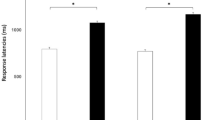Abstract
The unit-decade compatibility effect describes longer response times and higher error rates for incompatible (e.g., 37_52) than compatible (e.g., 42_57) number comparisons. Recent research indicated that the effect depends on the percentage of same-decade filler items. In the present study, we further examined this relationship by recording participants’ eye-fixation behaviour. In four conditions, participants had to compare item sets with different filler item types (i.e., same-decade and same-unit filler items) and different numbers of same-decade filler items (i.e., 25, 50, and 75 %). We found a weaker unit-decade compatibility effect with most fixations on tens in the condition with same-unit filler items. Moreover, the compatibility effect increased with the percentage of same-decade filler items which was accompanied by less fixations on tens and more fixations on units. Thus, our study provides first eye-tracking evidence for the influence of cognitive control in number processing.



Similar content being viewed by others
Notes
Please note that in the literature same-decade fillers are usually referred to as within-decade fillers. However, to improve discernibility from same-unit fillers (e.g., 53_73) in our qualitative manipulation of filler items, we decided to use these more distinctive terms.
References
Botvinick, M. M., Braver, T. S., Barch, D. M., Carter, C. S., & Cohen, J. D. (2001). Conflict monitoring and cognitive control. Psychological Review, 108, 624–652.
Botvinick, M. M., Cohen, J. D., & Carter, S. C. (2004). Conflict monitoring and anterior cingulate cortex: An update. Trends in Cognitive Sciences, 8, 539–546.
Dehaene, S., Dupoux, E., & Mehler, J. (1990). Is numerical comparison digital? Analogical and symbolic effects in two-digit number comparison. Journal of Experimental Psychology: Human Perception and Performance, 16, 626–641.
Gallistel, C. R., & Gelman, R. (1992). Preverbal and verbal counting and computation. Cognition, 44, 43–74.
Ganor-Stern, D., Tzelgov, J., & Ellenbogen, R. (2007). Automaticity and two-digit numbers. Journal of Experimental Psychology: Human Perception and Performance, 33, 483–496.
Hinrichs, J. V., Yurko, D. S., & Hu, J. (1981). Two-digit number comparison: Use of place information. Journal of Experimental Psychology: Human Perception and Performance, 7, 890–901.
Kallai, A. Y., & Tzelgov, J. (2012). The place-value of a digit in multi-digit numbers is processed automatically. Journal of Experimental Psychology: Learning, Memory, and Cognition, 38, 1221–1233.
Korvorst, M., & Damian, M. F. (2008). The differential influence of decades and units on multi-digit number comparison. The Quarterly Journal of Experimental Psychology, 61, 1250–1264.
Logan, G. D. (1980). Attention and automaticity in Stroop and priming tasks: Theory and data. Cognitive Psychology, 12, 523–553.
Macizo, P., & Herrera, A. (2008). The effect of number codes in the comparison task of two-digit numbers. Psicológica, 29, 1–34.
Macizo, P., & Herrera, A. (2010). Two-digit number comparison: Decade-unit and unit-decade produce the same compatibility effect with number words. Canadian Journal of Experimental Psychology, 64, 17–24.
Macizo, P., & Herrera, A. (2011). Cognitive control in number processing: Evidence from the unit-decade compatibility effect. Acta Psychologica, 136, 112–118.
Macizo, P., & Herrera, A. (2012). The processing of Arabic numbers is under cognitive control. Psychological Research. doi:10.1007/s00426-012-0456-6.
Mann, A., Moeller, K., Pixner, S., Kaufmann, L., & Nuerk, H.-C. (2012). On the development of Arabic three-digit number processing in primary school children. Journal of Experimental Child Psychology, 113, 594–601.
Merkley, R., & Ansari, D. (2010). Using eye-tracking to study numerical cognition: the case of the numerical ratio effect. Experimental Brain Research, 206, 455–460.
Meyerhoff, H. S., Moeller, K., Debus, K., & Nuerk, H.-C. (2012). Multi-digit number processing beyond the two-digit number range: A combination of sequential and parallel processes. Acta Psychologica, 140, 81–90.
Moeller, K., Fischer, M. H., Nuerk, H.-C., & Willmes, K. (2009). Sequential or parallel processing of two-digit numbers? Evidence from eye-tracking. The Quarterly Journal of Experimental Psychology, 62, 323–334.
Moeller, K., Klein, E., & Nuerk, H.-C. (2011). Three processes underlying the carry effect in addition–evidence from eye-tracking. British Journal of Psychology, 102, 623–645.
Moeller, K., Klein, E., & Nuerk, H.-C. (2013). Influences of cognitive control in numerical cognition–adaptation by binding for implicit learning. Topics in Cognitive Science, 5, 335–353.
Moyer, R. S., & Landauer, T. K. (1967). The time required for judgments of numerical inequality. Nature, 215, 1519–1520.
Notebaert, W., & Verguts, T. (2008). Cognitive control acts locally. Cognition, 106, 1071–1080.
Nuerk, H.-C., Moeller, K., Klein, E., Willmes, K., & Fischer, M. H. (2011). Extending the mental number line: a review of multi-digit number processing. Journal of Psychology, 219, 3–22.
Nuerk, H.-C., Weger, U., & Willmes, K. (2001). Decade breaks in the mental number line? Putting the tens and units back in different bins. Cognition, 82, B25–B33.
Nuerk, H.-C., Weger, U., & Willmes, K. (2002). A unit-decade compatibility effect in German number words. Current Psychology Letters: Behavior, Brain, & Cognition, 2, 19–38.
Nuerk, H. C., & Willmes, K. (2005). On the magnitude representations of two-digit numbers. Psychology Science, 47, 52–72.
Poltrock, S. E., & Schwartz, D. R. (1984). Comparative judgement of multi-digit numbers. Journal of Experimental Psychology: Learning, Memory, and Cognition, 10, 32–45.
Rayner, K., & Pollatsek, A. (1989). The psychology of reading. Englewood Cliffs: Prentice Hall.
Restle, F. (1970). Speed of adding and comparing numbers. Journal of Experimental Psychology, 83, 32–45.
Shepard, R. N., Kilpatrick, D. W., & Cunningham, J. P. (1975). The internal representation of numbers. Cognitive Psychology, 7, 82–138.
Tzelgov, J., Henik, A., & Berger, J. (1992). Controlling Stroop effects by manipulating expectations for color words. Memory & Cognition, 20, 727–735.
Verguts, T., & Notebaert, W. (2008). Hebbian learning of cognitive control: Dealing with specific and nonspecific adaptation. Psychological Review, 115, 518–525.
Verguts, T., & Notebaert, W. (2009). Adaptation by binding: a learning account of cognitive control. Trends in Cognitive Science, 13, 252–257.
Acknowledgments
We thank Ian Mackenzie for proof-reading of the manuscript.
Author information
Authors and Affiliations
Corresponding author
Rights and permissions
About this article
Cite this article
Huber, S., Mann, A., Nuerk, HC. et al. Cognitive control in number magnitude processing: evidence from eye-tracking. Psychological Research 78, 539–548 (2014). https://doi.org/10.1007/s00426-013-0504-x
Received:
Accepted:
Published:
Issue Date:
DOI: https://doi.org/10.1007/s00426-013-0504-x




